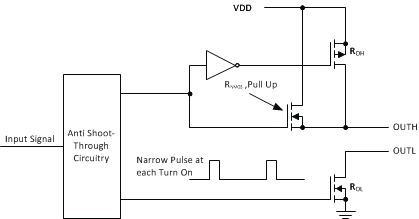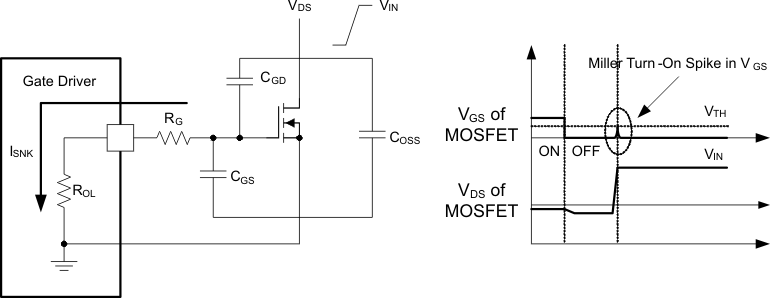JAJSBW9A February 2013 – September 2024 UCC27532
PRODUCTION DATA
- 1
- 1 特長
- 2 アプリケーション
- 3 概要
- 4 Pin Configuration and Functions
- 5 Specifications
- 6 Detailed Description
- 7 Application and Implementation
- 8 Layout
- 9 Device and Documentation Support
- 10Revision History
- 11Mechanical, Packaging, and Orderable Information
パッケージ・オプション
デバイスごとのパッケージ図は、PDF版データシートをご参照ください。
メカニカル・データ(パッケージ|ピン)
- DBV|6
サーマルパッド・メカニカル・データ
発注情報
6.2.4 Output Stage
The output stage of the UCC27532 device is illustrated in Figure 6-2. The UCC27532 device features a unique architecture on the output stage which delivers the highest peak source current when it is most needed during the Miller plateau region of the power switch turn-on transition (when the power switch drain/collector voltage experiences dV/dt). The device output stage features a hybrid pull-up structure using a parallel arrangement of N-Channel and P-Channel MOSFET devices. By turning on the N-Channel MOSFET during a narrow instant when the output changes state from low to high, the gate driver device is able to deliver a brief boost in the peak sourcing current enabling fast turn on.
 Figure 6-2 UCC27532 Gate Driver Output Stage
Figure 6-2 UCC27532 Gate Driver Output StageThe ROH parameter (see Electrical Table) is a DC measurement and it is representative of the on-resistance of the P-Channel device only, since the N-Channel device is turned-on only during output change of state from low to high. Thus the effective resistance of the hybrid pull-up stage is much lower than what is represented by ROH parameter. The pull-down structure is composed of a N-Channel MOSFET only. The ROL parameter (see Section 5.4), which is also a DC measurement, is representative of true impedance of the pull-down stage in the device. In UCC27532, the effective resistance of the hybrid pull-up structure is approximately 3 x ROL.
The UCC27532 is capable of delivering 2.5-A source, 5-A Sink (asymmetrical drive) at VDD = 18 V. Strong sink capability in asymmetrical drive results in a very low pull-down impedance in the driver output stage which boosts immunity against the parasitic Miller turn-on (high slew rate dV/dt turn on) effect that is seen in both IGBT and FET power switches .
An example of a situation where Miller turn on is a concern is synchronous rectification (SR). In SR application, the dV/dt occurs on MOSFET drain when the MOSFET is already held in Off state by the gate driver. The current charging the CGD Miller capacitance during this high dV/dt is shunted by the pull-down stage of the driver. If the pull-down impedance is not low enough then a voltage spike can result in the VGS of the MOSFET, which can result in spurious turn on. This phenomenon is illustrated in Figure 6-3.
 Figure 6-3 Low Pull-Down Impedance in UCC27532 (output stage mitigates Miller turn-on effect)
Figure 6-3 Low Pull-Down Impedance in UCC27532 (output stage mitigates Miller turn-on effect)The driver output voltage swings between VDD and GND providing rail-to-rail operation, thanks to the MOS output stage which delivers very low dropout. The presence of the MOSFET body diodes also offers low impedance to switching overshoots and undershoots. This means that in many cases, external Schottky diode clamps may be eliminated.